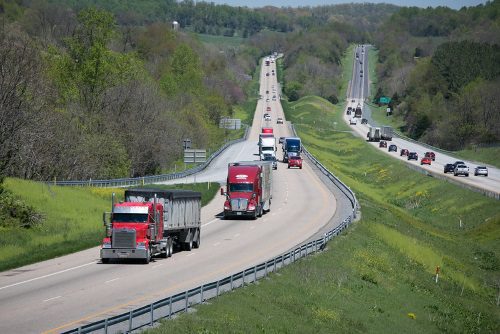National Freight Report Highlights Growing Capacity Challenges

The growth in commercial truck freight could be put at risk by inadequate highway capacity; lack of funding for improving the freight network and a shortage of truck drivers.
[Above photo by the Virginia DOT.]
That’s according to a new 37-page report issued October 3 by the national transportation research firm TRIP, which projects that freight moved annually in the United States by commercial trucks is expected to increase 91 percent in inflation-adjusted dollar value by 2045 and 44 percent by weight.

TRIP’s report offered several recommendations for enhancing the nation’s freight transportation system, including: improving the reliability and condition of intermodal connectors between major highways and rail, ports and waterways; continued development of vehicle autonomy and the further automation of warehousing; providing funding for dedicated and multimodal freight transportation improvements; and providing a permanent, adequate, and reliable revenue fix for the federal Highway Trust Fund as a critical step towards funding a 21st Century freight transportation system.

“It’s clear that the safe and efficient movement of goods and services depends on a well-funded national transportation system,” noted Jim Tymon, executive director of the American Association of State Highway and Transportation Officials in a statement. “Without strong investment from our federal partners, state departments of transportation won’t be able to meet the growing demands on the system.”
TRIP’s report emphasized several key aspects of the country’s freight transportation system, along with major trends affecting it, including:
- The nation’s freight system moves a daily average of approximately 51 million tons of freight valued at approximately $55 billion, which jumps to 17.7 billion tons of freight on an annual basis, valued at approximately $16.8 trillion.
- From 2014 to 2018, U.S. e-commerce increased by 69 percent – from $298 billion to $505 billion – and is expected to increase another 39 percent by 2022 to $706 billion.
- Modern society is likely to become even more reliant on trucking and other types of shipments as international trade continues to increase, domestic demand for freight movement increases, and commercial and retail models increasingly rely on timely and efficient freight deliveries.
- But the U.S. Department of Transportation forecasts that between 2012 and 2045, the miles of major U.S. highways that are congested during peak periods will quadruple from 19,200 miles to 78,500 miles.
- Additionally, roughly 68 percent of intermodal connectors – roads that provide the “last-mile” connection between freight facilities – are congested and 56 percent of intermodal connectors have pavements in poor condition.
“Addressing the nation’s need for a more efficient and safer freight transportation system will require increased investment in improvements to network capacity and safety, greater multijurisdictional cooperation to facilitate large transportation projects, and further technological advancements in the nation’s supply chain, including vehicles, warehouses and logistics,” TRIP’s report noted.

“Improving freight transportation flow will require that the capacity of the nation’s freight transportation system is expanded, particularly at major bottlenecks, including portions of interstate highways and major trade gateways and corridors, rail facilities, and ports,” it said.
Relieving institutional challenges to improved freight transportation is also a key need, requiring the further streamlining of transportation project planning, review, permitting and the facilitation of greater multijurisdictional collaboration on multimodal freight transportation solutions, the report added.
“Making needed improvements to the nation’s freight transportation system will require establishing funding for freight transportation improvements that is substantial, continuing, multimodal, reliable, and, in most cases, specifically dedicated to freight transportation projects,” it said.
Neste to lead its Renewable Polymers and Chemicals business from its office in Düsseldorf, Germany
October 8, 2019


